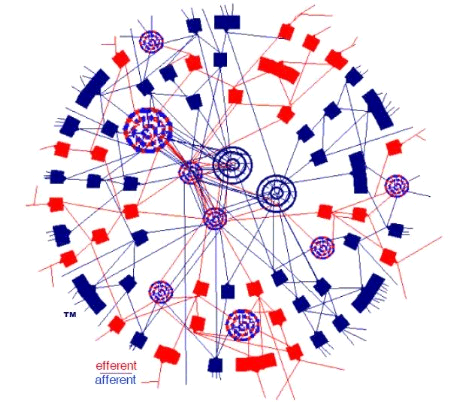Inward, inbound, or bottom-up propagation is called
afferent propagation in biological terms. It defines propagation of stimulus and influences from the outside world or from systems or layers that are closer to the outside world than the network objects they stimulate (i.e.,
distal to
proximal). Afferent propagation carries sensory information, and information derived from sensory information, such as error deltas. The term
"bottom-up" is used as a loose synonym for afferent propagation in some circles.
Outward, outbound, or top-down propagation is called
efferent propagation in biological terms. It defines propagation of stimulus and other influences from components inside the network to the outside world or from network components that are farther removed from the outside world than the network objects they stimulate (i.e.,
proximal to
distal). The term
"top-down" is used as a loose synonym for efferent propagation in some circles.

Any Connectome You'd Like No 1
Efferent propagation is generally known for carrying motor and effector information. It is also thought to carry information required of network systems to filter and adjust afferent (inbound) sensory signals. This filter information is probably best thought of as
expectation information, which is used, by lower level networks, to produce difference-deltas. The deltas between expectation and actual sensory information is then returned (afferent) to higher level processes.
A good real-world example of how efferent (top-down) influences affect how we perceive incoming stimuli can be seen in the
kinetic depth effect, which shows how our brains, having been taught of the 3-dimensional nature of their environment, will impose three dimensions on incoming sensory information. This tends to force sensory information to be perceived in a manner that is consistent with the organism's existing perceptions (learned or
innate) of its milieu. This makes it an error-correcting means which can sometimes be very wrong (see the rotating mask illusion at the entry for the
Kinetic Depth Effect). However, on balance, it seems to produce much better results than un-filtered stimuli.
 Stand Out Publishing
Stand Out Publishing